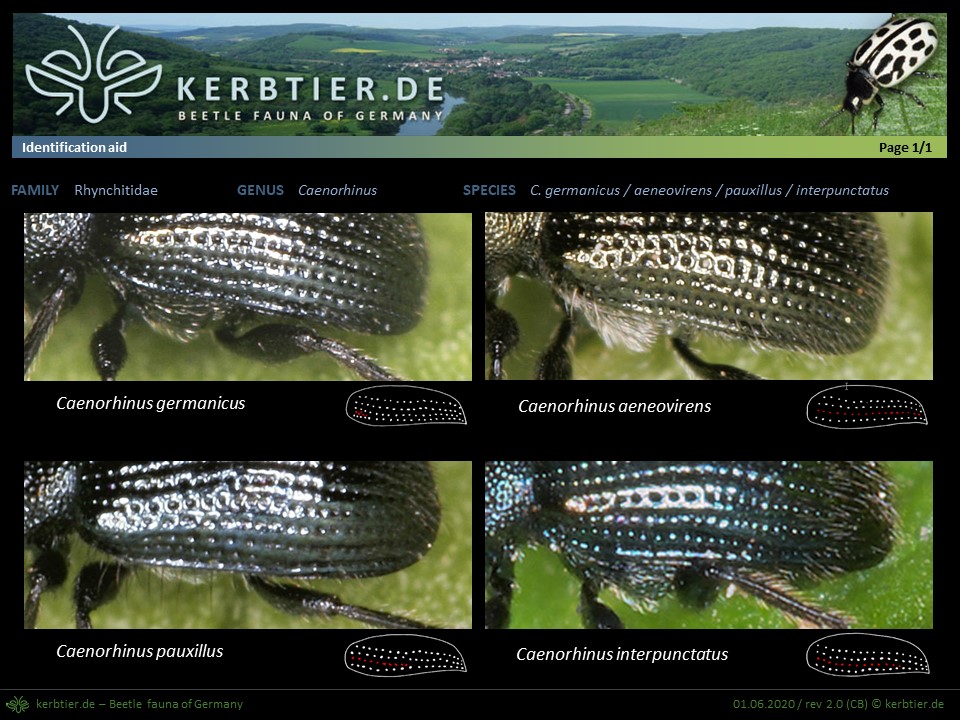Available: 4 taxonomic notes | |
|
2020-05-09 / HH
Distinguishing the Paederus speciesI would like to draw your attention to the fact that the ID of Paederus species needs to be done with care. There is P. littoralis (common, rather in dry habitats), P. berevipennis (rare, only in dry habitats, e.g. calcareous grassland) and P. schoenherri (only in southern Bavarian and in moist habitats). These species can be recognized by their short elytra and can be identified from photos. The other species are considerably more challenging: P. riparius is the most common and the largest species with almost entirely light-colored legs. However, since a few years there are records of P. balcanicus from ST and BR and I assume that this species is distributed more widely. They can be distinguished by the shape of the head. Finally, the last three species live in moist habitats, among them P. fuscipes (common, long elytra), P. limniphilus (rare) and P. caligatus (rare). The latter two have more or less entirely dark tibiae, whereas P. fuscipes has only slightly darkened tibiae. Hence, good photos are required, with a good dorsal view and the legs visible. Together with a measured body length, the species can be determined to species level. Genus: Paederus (Family: Staphylinidae) Species: littoralis, brevipennis, schoenherri, riparius, balcanicus, fuscipes, limnophilus, caligatus |
17
|
|
2020-07-23 / CB
On the Oedemera lurida complexI should like to point out, that since this spring we have stopped to determine O. virescens and the species from the O. lurida complex to species level with very few exceptions. The largest of these species, O. virescens, is 8-11 mm large and very common in our fauna. The males exhibit thickened hind thighs. Slightly smaller (7.3-9.3 mm) is O. monticola. Their males have thickened hind thighs as well. This species is found in the low mountain range and is missing in the lowlands. Even smaller (5-7 mm, exceptionally larger specimens might reach 9 mm) is O. lurida. In this species, males have no thickened hind thighs. It is common in our fauna. The last species from this complex, O. viridula, can not be distinguished from O. lurida from live photos. Its taxonomic status is still not fully clarified. Details on the identification can be found here. Genus: Oedemera (Family: Oedemeridae) Species: lurida, monticola, viridula, virescens |
5
|
|
2021-01-06 / CB
On Tetrops praeustusI would like to inform our users that a publication by J. Kurzawa was published in November 2020 (in Polish). Accordingly, in addition to Tetrops praeustus, there is another species in Central Europe, Tetrops gilvipes adlbaueri Lazarev, 2012, which can only be distinguished based on the genitalia. We shall therefore only determine Tetrops praeustus to genus level. I have already withdrawn our previous identifications. The distribution maps will be cleaned up with the next update in early February. Genus: Tetrops (Family: Cerambycidae) Species: praeustus |
10
|
|
2020-10-03 / CB
On Asiorestia (Neocrepidodera) transversaI would like to notify our users, that we will cease to identify Asiorestia (Neocrepidodera) transversa to species level from locations in the Alps and their foothills, due to the occurrence of the similar, but rarer Asiorestia brevicollis, which can be hardly distinguished from photos. This is valid all records south of map sheet 7800 (latitude of Munich). I have changed approx. 70 earlier records to Asiorestia cf. transversa and removed them from our distribution maps. Genus: Asiorestia (Family: Chrysomelidae) Species: transversa, brevicollis |
9
|

















